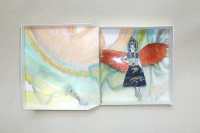Acts of Mourning
The strength of our species’ will to live has been celebrated in stories since prehistory, often found as the subject in the visual and performing arts. But the long, extended, black, somber personal state of mourning has no outwardly communicable drama. We pay tribute, share memories, give emotional support and try to provide hope so that the grieving one can move forward: “Find closure. Put it behind you.”
My coping mechanism for handling grief is to make something. I make series of objects which serve as memorials to a loved one, mine or the sons and daughters lost in the wars in Iraq and Afghanistan (see Looking Down page).
The cardiologist told my older sister that she had from two to six months to live. That prognosis was hard to absorb, so I went into the studio and made paper images of her using old photos and whimsical bits for hats and wings and attached them to paper boxes. When standing side by side from the back, the twelve boxes reveal text which represents a love letter written to her from our mother in celebration of her 40th birthday. She lived for another two years. We spent 72 years together.
What is impossible to see is that the paper figures are set in higher relief than the backgrounds. Important to these is that each has wings and a very fancy headpiece. These two factors are precursers to the boxes in Memento Mori. The paper boxes are fabricated from a series of daily drawings done over a period of four years entitled Day Circles.




































